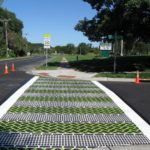How Long is a Standard Parking Space
Parking is an essential space in the urban space, as the automobile is part of the most of urban life. Generally, a parking space is known as a location that is designated for parking (either paved or unpaved). Parking spaces can be in a parking garage, in a parking lot or on a city street. How do we know that certain space designated for parking? It is usually a space delineated by road surface markings. In the United States, the size of parking spaces varies. Typically parking spaces fall between 7.5 to 9 feet wide and 10 to 20 feet long. The most common size is 8.5 feet wide by 19 feet long.
Several variables can influence the size of parking spaces, namely the vehicle size and measurement, cost and availability of the land and type of parking arrangement (parallel, perpendicular or angle parking. The latter is types of commonly used arrangements of parking spaces that are self-park configurations where the vehicle driver is able to access the parking independently.
Parallel parking
With parallel parking of cars, these are arranged in a line, with the frontage bumper of one car facing the back bumper of an nearby car. This is done parallel to a curb when one is provided. Parallel parking is the most general mode of street side parking for cars. It may also be used in parking lots and parking structures, but usually only to complement parking spaces that use the other modes.
A parallel parking space is widely customary as approximately 9.1 feet wide by 20 feet long. However, many parallel parking spaces are larger or smaller in contrast with these measurements.
Perpendicular Parking or Bay Parking

In this type of arrangement, cars are parked side by side, perpendicular to an aisle, curb, or wall. This type of car parking accommodates more cars per length of road (or curb) than parallel parking and is therefore generally used in car parking lots and car parking structures. In North America, the width perpendicular parking spaces usually range from 7.5 to 9.0 feet (2.3–2.7 m).
Angle parking or Echelon Parking
This arrangement is similar to perpendicular parking for these vehicles, except that cars are set at an angle to the aisle (an acute angle with the direction of approach). The gentler turn allows easier and quicker parking, narrower aisles, and thus higher density than perpendicular parking. While in theory, the aisles are one-way, in practice they are typically wide enough to allow two cars to pass slowly when drivers go down the aisles the wrong way. Similar to perpendicular parking spaces of North America, the width of angled usually ranges from 7.5 to 9.0 feet (2.3–2.7 m). For example, normal parking spaces in the city of Dallas, Texas are 8.5 feet (2.6 m) wide, while squashed spaces are 7.5 feet (2.3 m) wide.
Contact us
 Phone Call |
 Text Message |
 |







